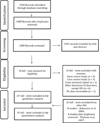Prevalence, Risk Factors, and Outcomes of Irritable Bowel Syndrome After Infectious Enteritis: A Systematic Review and Meta-analysis
- PMID: 28069350
- PMCID: PMC5367939
- DOI: 10.1053/j.gastro.2016.12.039
Prevalence, Risk Factors, and Outcomes of Irritable Bowel Syndrome After Infectious Enteritis: A Systematic Review and Meta-analysis
Abstract
Background & aims: Foodborne illness affects 15% of the US population each year, and is a risk factor for irritable bowel syndrome (IBS). We evaluated risk of, risk factors for, and outcomes of IBS after infectious enteritis.
Methods: We performed a systematic review of electronic databases from 1994 through August 31, 2015 to identify cohort studies of the prevalence of IBS 3 months or more after infectious enteritis. We used random-effects meta-analysis to calculate the summary point prevalence of IBS after infectious enteritis, as well as relative risk (compared with individuals without infectious enteritis) and host- and enteritis-related risk factors.
Results: We identified 45 studies, comprising 21,421 individuals with enteritis, followed for 3 months to 10 years for development of IBS. The pooled prevalence of IBS at 12 months after infectious enteritis was 10.1% (95% confidence interval [CI], 7.2-14.1) and at more than 12 months after infectious enteritis was 14.5% (95% CI, 7.7-25.5). Risk of IBS was 4.2-fold higher in patients who had infectious enteritis in the past 12 months than in those who had not (95% CI, 3.1-5.7); risk of IBS was 2.3-fold higher in individuals who had infectious enteritis more than 12 months ago than in individuals who had not (95% CI, 1.8-3.0). Of patients with enteritis caused by protozoa or parasites, 41.9% developed IBS, and of patients with enteritis caused by bacterial infection, 13.8% developed IBS. Risk of IBS was significantly increased in women (odds ratio [OR], 2.2; 95% CI, 1.6-3.1) and individuals with antibiotic exposure (OR, 1.7; 95% CI, 1.2-2.4), anxiety (OR, 2; 95% CI, 1.3-2.9), depression (OR, 1.5; 95% CI, 1.2-1.9), somatization (OR, 4.1; 95% CI, 2.7-6.0), neuroticism (OR, 3.3; 95% CI, 1.6-6.5), and clinical indicators of enteritis severity. There was a considerable level of heterogeneity among studies.
Conclusions: In a systematic review and meta-analysis, we found >10% of patients with infectious enteritis develop IBS later; risk of IBS was 4-fold higher than in individuals who did not have infectious enteritis, although there was heterogeneity among studies analyzed. Women-particularly those with severe enteritis-are at increased risk for developing IBS, as are individuals with psychological distress and users of antibiotics during the enteritis.
Keywords: Functional Gastrointestinal Disorders; Gastrointestinal Infections; Microbes; Post-Infectious Irritable Bowel Syndrome.
Copyright © 2017 AGA Institute. Published by Elsevier Inc. All rights reserved.
Conflict of interest statement
Figures



Comment in
-
Irritable Bowel Syndrome: An Infectious Disease?Gastroenterology. 2017 Apr;152(5):936-938. doi: 10.1053/j.gastro.2017.02.028. Epub 2017 Mar 1. Gastroenterology. 2017. PMID: 28259791 No abstract available.
References
-
- Chey WD, Kurlander J, Eswaran S. Irritable bowel syndrome: a clinical review. JAMA. 2015;313:949–958. - PubMed
-
- Spiller R, Garsed K. Postinfectious irritable bowel syndrome. Gastroenterology. 2009;136:1979–1988. - PubMed
-
- Chaudhary NA, Truelove SC. The irritable colon syndrome. A study of the clinical features, predisposing causes, and prognosis in 130 cases. Q J Med. 1962;31:307–322. - PubMed
Publication types
MeSH terms
Substances
Grants and funding
LinkOut - more resources
Full Text Sources
Other Literature Sources
Medical
Miscellaneous

